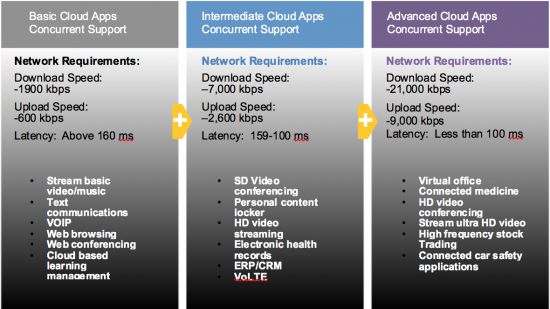































 Co-written with Taru Khurana,Senior Analyst, SP Thought Leadership
Co-written with Taru Khurana,Senior Analyst, SP Thought Leadership
The ubiquitous nature of Internet of Everything (IoE) is driving a digital transformation in many industries and businesses. This digital disruption has already begun and it's driving advanced cloud access and network performance requirements for a wide range of devices and machine-to machine (M2M) connections. Faster broadband speeds and lower latencies as well as wider network access are essential enablers for the future of IoE that many envision. The growing number of cloud applications that are being developed for a wide variety of business and consumer uses are dramatically changing the demands and expectations of public and private network services.
Consider the connected car. Integrated "infotainment" is a growing feature trend that is being implemented in many types of vehicles. This type of mobile connectivity will create even more reliance on the Internet to bringaudio, video, and navigational content to the vehicle. Critical applications such as the connected car safety applications can't compromise when it comes to vehicle-to-vehicle or vehicle-to-user communications - broadband needs will be more stringent (requiring a latency of nearly 10 milliseconds). The traffic signal violation warning, pre-crash sensing and stop sign movement assistance as well as other in-vehicle warning systems need to communicate in split seconds, this is imperative to the safety of smart car drivers and passengers.
In the healthcare industry, the transformation due to IoE has already begun in select geographies with secure access to electronic health records (EHR). Sensors for heart rate variability, blood oxygen levels, blood pressure, glucose levels, ECG and other medical testing offer a wide range of well-being and biometric information. These metrics provide a profile of a patient's health, emotional and physical state and can be tracked remotely by healthcare providers. The requirements of healthcare applications are varied. While the latency requirements for an end user to access EHR is around 100 milliseconds, live/real time monitoring of patients will require much lower latencies and higher bandwidth.

Source: Cisco Global Cloud Index
IoE will transform pedagogy with hybrid and customized learning using learning management systems that make to make teaching and learning highly accessible and easier. Today's commonly used learning management systems' latency requirements for the end user are around 160 milliseconds, which makes the tools very accessible to the general public. Many countries' fixed and mobile network resources can support that level of cloud computing today (see the Cisco Global Cloud Index Cloud readiness supplement). As advances are made with high-definition videoconferencing tools being used to create virtual classroom experiences, the broadband requirements will be more stringent.
From a consumer perspective, end user broadband quality has never been more important than today, where some IoE connected home applications require low latency due to interactive and live nature of data transfer (e.g., video surveillance/security). And the repercussions of having a slow connection are beyond an interrupted Netflix movie or Skype session.
Because of these data types, the impact on storage in the data center will be tremendous. IT administrators, already tasked with "keeping the lights on" in regard to the current storage infrastructure, will now be tasked with figuring out how to store, manage, protect and make accessible this diversified nature of data. Gartner predicts that storage capacity utilization rates with enterprises are between 30% and 50%, so the capacity overhead may be there, but the management of it is critical where data can be accessed quickly without impacting critical application availability and the well-being of the end consumer.
To learn and see more about the IoE innovations and applications that are happening around the world, visit Cisco's Internet of Everything site.
We want to hear from you! Please feel free to comment, share and connect with us on Facebook and @CiscoSP360.
 Tags quentes :
Nuvem
Internet of Things (IoT)
Internet of Everything (IOE)
IoE
Banda larga
Cisco Global Cloud Index
cisco vni forecast
datacenters
cloud storage services
Tags quentes :
Nuvem
Internet of Things (IoT)
Internet of Everything (IOE)
IoE
Banda larga
Cisco Global Cloud Index
cisco vni forecast
datacenters
cloud storage services